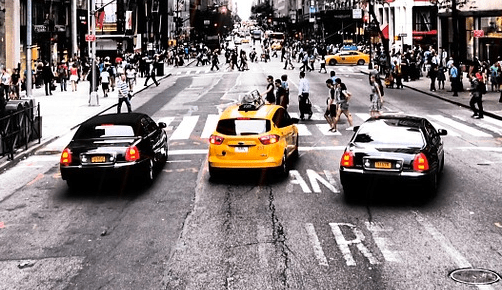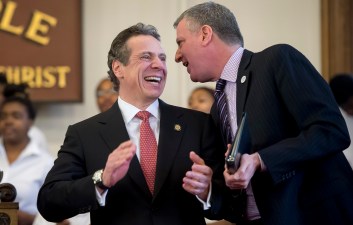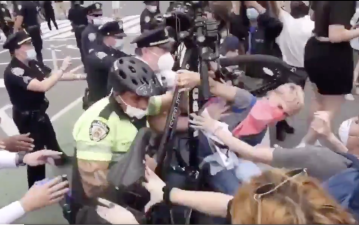IT’S ON: Manhattan Below 96th to Be Car-Free During Curfew (Not How Activists Wanted It, Though)

The city’s curfew — which now begins at 8 p.m. and will last multiple days — now includes a partial ban on vehicular traffic in Manhattan below 96th Street, a ban that includes Ubers and Lyfts until 12:30 a.m., the latest in a series of policy moves that are spinning out of City Hall by the minute.
TRAFFIC CLOSURE:
At 8pm tonight when the #curfew begins in #NYC, there will be NO vehicular traffic allowed south of 96th Street in Manhattan — with the exception of residents, essential workers, busses, and truck deliveries. pic.twitter.com/bpiVb45Gej— Terence Monahan (@TerenceMonahan) June 2, 2020
No other details were included from the NYPD about this massive change in city mobility, but clarification started being provided in a scattershot manner all evening.
Here’s what we know:
- The curfew is now from 8 p.m. to 5 a.m.
- During the curfew, there will be no driving in Manhattan below 96th Street, except for essential workers and deliveries.
- There will be no Uber or Lyft or other app-based taxis between 8 p.m. and 12:30, when those high-volume taxis can return — a concession to the fact that the subways are now shutting down at 1 a.m. for cleaning.
- Yellow cabs can operate throughout the curfew, but must be “transporting an essential worker or individuals seeking medical treatment/supplies” in the 8 p.m. to 12:30 a.m. period, according to the Taxi and Limousine Commission.
- Citi Bike and Revel scooters have already acquiesced to the NYPD and are deactivating their systems during the curfew.
When asked for the answers to such questions, the NYPD press office sent over a link to another tweet that offered the same information as Monahan’s — plus a platitude: “The NYPD remains deeply committed to serving the people of NYC & is asking for everyone’s cooperation.”
The fact that Uber and Lyft can operate after 12:30 a.m. will mitigate the difficulty for essential workers, who longer have access to the subway between 1 and 5 a.m. due to coronavirus cleansing.
Lyft told Streetsblog that it was told about the new policy by the city at 4:45 p.m — after it was announced by the city.
“We were just told that Mayor de Blasio and NYPD are mandating that rideshare companies stop operating tonight, from 8 p.m. to 12:30 a.m. We know this is difficult for those who rely on Lyft, especially essential workers and those needing to get home. We are working hard to reach an agreement that best supports New Yorkers.
The lack of a ban on yellow cabs raises its own questions, given that yellow cabbies have been accused in the past of not picking up passengers of color or declining to take riders outside of Manhattan.
Citi Bike seemed to be shutting down early:
It appears that a large swath of the CitiBike network is already inactive, a few hours before curfew. pic.twitter.com/nHQ50DASzJ
— Second Ave. Sagas (@2AvSagas) June 2, 2020
The news was first reported by NBC reporter Myles Miller:
EXCLUSIVE: NYPD officials tell @NBCNewYork all traffic south of 96 St. will be restricted to essential workers, commercial deliveries, and residents starting at 8p. This will mean the closing of the West Side Highway and FDR Drive.
— Myles Miller (@MylesMill) June 2, 2020
The curfew is an effort to thwart protesters who are outraged at police brutality, specifically the police killings of unarmed black men, most recently George Floyd in Minneapolis.
At a morning rally in Foley Square, the Rev. Al Sharpton told reporters that he opposed the curfew, even before it was lengthened by three hours.
“What they’re calling for is not peace; they’re calling for quiet,” he said of the mayor and his NYPD. “They are telling us to shut up and suffer in silence If you want peace, you bring justice. If you want quiet, you bring curfews.”
As such, no one is cheering the car-free portion of Manhattan, no matter how long street safety advocates have been calling for it.
“Many of us want to see fewer motor vehicles and significant car-free spaces in the city to enable and expand the physical freedom of New Yorkers and visitors to walk, ride bikes and interact in our phenomenal urban places,” said Jon Orcutt of Bike New York, and a former DOT official. “But this vehicle restriction is part of locking the city down entirely, which is antithetical to the very nature of cities and public life. … I look forward to the end of police restriction and resumption of our democratic fight for a city built for people.”
And Danny Pearlstein of the Riders Alliance saw the flip side of City Hall’s ability to act quickly … when it wants to.
“If they can do this to protect property, they can put bus riders first much more widely on streets for an equitable recovery from COVID,” he said.




